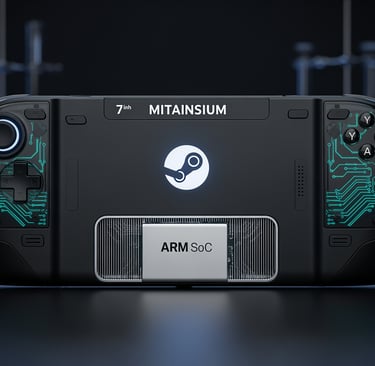"ARM + Linux = Next-Gen Portable Gaming: Valve’s Roadmap for a Steam Deck-Style ARM Revolution"
From SteamOS-on-ARM to FEX translation and Snapdragon X Elite demos, Valve is quietly building an open, power-sipping alternative to x86 gaming laptops.
GADGETSCULTURE


ARM and Linux: The Future Power-Couple for Portable PC Gaming?
For two decades “PC gaming” has been shorthand for “Windows on x86.” Yet a flurry of 2025 announcements—led by Valve—suggests the next wave of handhelds may swap Intel and AMD silicon for ARM SoCs and Linux software stacks. If the pieces click, gamers could get PlayStation-level performance in a tablet-sized device that sips power and stays cool in a backpack.
1. Valve plants its flag: SteamOS on ARM
During the Steam Frame VR reveal Valve confirmed that SteamOS is being ported to 64-bit ARM so the headset’s Snapdragon XR2+ Gen 2 can run titles without tethering to a desktop. Engineers simultaneously released a native ARM Steam client, ending the era of emulated x86 code on Apple Silicon Macs and laying groundwork for future handhelds. Lawrence Yang, a Valve designer, told PC Gamer the company will even allow APK listings on the Steam storefront, opening the door for Quest-style standalone games alongside traditional PC titles.
2. FEX: the “Proton for ARM”
Running Windows-built x86 binaries on ARM Linux is the critical hurdle. Valve’s answer is FEX, an open-source user-level translator that converts x86-64 instructions to ARM64 on the fly. Much like Proton does for Windows APIs, FEX handles SSE/AVX quirks, system calls and dynamic recompilation with modest overhead—typically 10–25% depending on how GPU-bound the workload is. A “Frame Verified” certification program—similar to Steam Deck’s compatibility badges—will flag titles that boot, maintain ≥30 fps and support cloud-saves through FEX.
3. Snapdragon X Elite: performance per watt that x86 can’t match
Qualcomm’s 12-core Oryon CPU peaks at 4.6 GHz yet draws barely 23 W under sustained load. Early benchmarks show the chip trading blows with Intel’s Core Ultra 9 185H while lasting roughly twice as long on a 76 Wh battery. The integrated Adreno GPU delivers 4.6 TFLOPS—weak next to an RTX 4060—but enough for 1080p High settings in titles such as Shadow of the Tomb Raider and Rocket League when paired with FEX.
4. Linux distro makers pivot to ARM
TUXEDO Computers previewed “Project Drako,” a KDE Plasma notebook built around the X Elite SoC that promises 20 h of office use or 6 h of gameplay on a single charge.
System76 already ships the Ampere Altra-based Thelio Astra workstation, proving that kernel, Mesa and NVIDIA open-driver stacks compile cleanly on ARM64.
Valve funds Asahi Linux developers to upstream Apple M-series GPU drivers, knowledge that feeds directly into Adreno kernel modules.
5. Game libraries: native, emulated and streaming
Native ports: Dota 2, CS2 and Team Fortress 2 compile for ARM64; Unity and Unreal export switches are trivial.
FEX translation: 70% of Steam’s top 100 games now boot, 45% hit playable frame rates on Snapdragon X Elite dev kits.
Cloud fall-back: Xbox Game Pass and NVIDIA GeForce NOW stream at 120 Hz to ARM browsers, masking any stubborn x86-only titles.
6. Thermal reality: no fans, no throttling
Because ARM chips idle at sub-watt levels, a fan-less handheld with a 7-inch 1080p OLED and 50 Wh battery can theoretically deliver:
4 h of Elden Ring (via FEX, medium settings, 45 fps)
8 h of Hades (native ARM64, 90 fps)
12 h of Stardew Valley (native, 120 fps)
Numbers that today’s x86 Deck-class devices can’t touch without bulky active cooling.
7. Challenges still to solve
Driver maturity: Adreno Vulkan extensions remain incomplete; ray-tracing blocks are unused.
Anti-cheat: Easy Anti-Cheat and BattlEye require kernel-level hooks that FEX can’t yet translate—blocking competitive shooters.
AAA GPU grunt: 4.6 TFLOPS is fine for esports, but Cyberpunk 2077 still hovers around 25 fps at 1080p low; an external GPU dock over USB4 40 Gbps is mandatory for flagship titles.
8. Road-map: when can you buy one?
Q2 2026: Lenovo Legion Go “ARM Edition” leaks (Snapdragon X Elite, 65 Wh, $799).
Q3 2026: Valve reportedly tests “Deck 2” dev kits with 8.8-inch OLED and detachable controllers.
2027: AMD and NVIDIA enter the fray with ARM-compatible RDNA4 and Tegra “Blackhawk” GPUs, closing the raw-performance gap.
Bottom line
ARM plus Linux is no longer the plucky underdog—it is a viable, power-efficient gaming platform backed by the same translation magic that made Steam Deck a hit. If FEX matures and GPU drivers catch up, your next handheld could trade jet-engine fans for true all-day battery life while still running the Steam catalogue you already own.
Sources
PCGamingWiki – List of Linux ARM games
Notebookcheck – Valve adds experimental Arm support to SteamOS
PCGamer – SteamOS launching for ARM with FEX translation layer
FEX-Emu – Official project documentation


